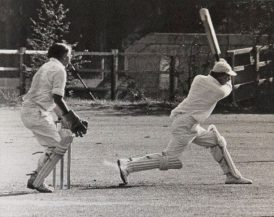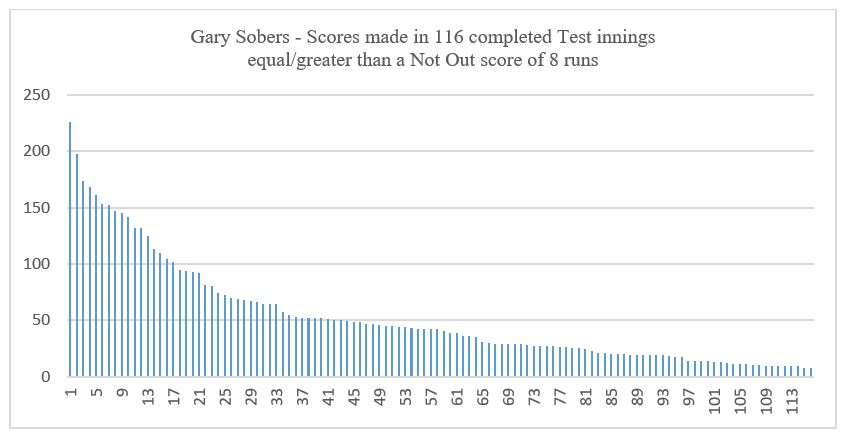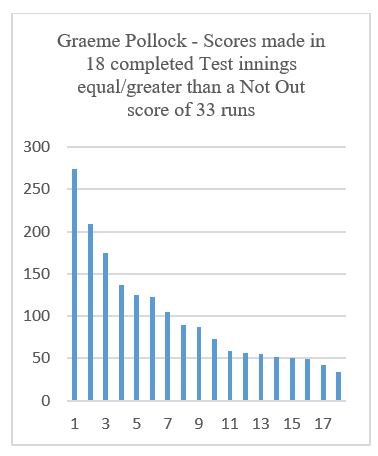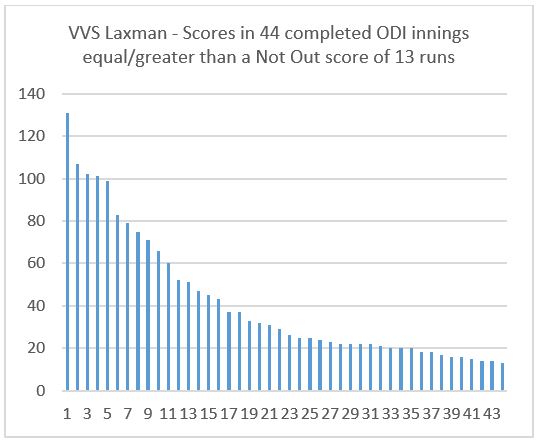
PART II – THE STRAIGHTFORWARD SCHOOL
Little doubt there have been many sorts of simple resolution devised by these collaborating in cricket boards and different casual settings. But, in revealed type, such options are few. Throughout a conscientious search I unearthed simply 4 of them, all originating within the new millennium. Three of those proposals revolve round a standard fundamental theme, however with vital variations.
Initially, although, some feedback are so as on two easy options. They’re briefly mentioned in an article of 2014 by Kartikeya Date, who’s a frequent author in varied boards on topical cricket issues. What he goes on to advocate is changing the Conventional Common by the typical rating of all innings (accomplished and Not Out) that lie throughout the vary of 0 to 100 runs. That is directed to combining batting “high quality and consistency”, and is proposed because it “accounts for occasions that happen steadily whereas the normal measure is disproportionately affected by occasions that happen solely hardly ever”.
Though this proposed statistic (which Date labels “the rating”) strays into totally different territory than this essay, at root is the easy variety of runs scored per innings performed. That exact measure hasn’t caught on as a alternative for the Conventional Common (as distinct from being an fascinating complementary notion), most likely as a result of it denies batsmen what is perhaps referred to as their rightful entitlements. However, as he notes, if the higher restrict for his personal proposal is ready excessive sufficient (at 400 runs, as a substitute of a cap at 100), it will boil right down to variety of runs scored per innings performed. This, I believe, can be much more palatable to specialist batsmen than his capped proposal. But even that model can be unsuitable for these making a comparatively excessive proportion of Not Out scores, mainly these of the decrease center order and tail.
The opposite easy measure that Date mentions is the Median Rating – ie the center worth of all of the scores a batsman makes. This seems to be rather a lot decrease than the Conventional Common (TA). For the Check profession of Brian Lara, the Median Rating is 33.5 for all innings and 33.0 excluding Not Outs (TA of 52.88); for Steve Waugh the corresponding figures are 25.5 and 20.0 (TA of 51.06); and for Mohinder Amarnath the figures are 30.0 in each instances (TA of 42.50). While the relativities so produced for these three specialist batsmen is perhaps thought affordable, the Median Scores given are closely influenced by failures occurring in the course of the playing-in section of an innings. And it’s throughout that section that good and unhealthy luck play a big position in figuring out whether or not or not a batsman survives to turn into properly established.
Having disposed of those two potential measures, I flip to think about the primary simple contributions in chronological order. The primary is a technique of deriving batting averages that’s implied by the Melbourne-based statistician Charles Davis. It’s contained in his e-book, The Better of The Finest (revealed in yr 2000) when discussing a fable in regards to the common affect of Not Out Innings on Conventional Averages (pages 96-98). While his favoured technique of dealing with Not Out Scores will not be immediately acknowledged, it has been detected by intently analyzing the related components of his textual content.
Davis’ graph (web page 97) exhibits an estimate of the extra runs {that a} batsman will add as he reaches successively greater scores in an finally accomplished innings, which ranges from the beginning of an innings (on zero) by means of to when on a rating of 255 (for many who have survived that lengthy). The information mirror the efficiency of the general careers of previous and current Check gamers.

Charles Davis – first of the Straightforwards
Substituting profession information on a person batsman for Davis’ generalised batsman (or generality of batsmen), such a graph can be utilized to point what that batsman would, doubtlessly, have gone on so as to add to his rating if not compelled to retire Not Out (although Davis himself doesn’t spotlight this level). Therefore, it may be used to make predictions of the probably end result of a given Not Out Rating for any explicit batsman.
The variety of runs usually added by Check batsmen after being on a specified undefeated rating is offered by Davis by way of each a Imply and a Median worth. He favours utilizing the set of Median values because the being a greater indicator of “most certainly outcomes” – that’s, of the extra runs anticipated to be made.
The second simple proposal emanates from Uday Damodaran, now a Professor on the Indian Institute of Administration at Udaipur (north-west India). That is outlined in his article of 2006. The proposal itself types an enter to his examine of ODI batting efficiency by the Indian workforce and takes up simply one of many article’s 4 pages. In comparable style to Davis, however explicitly laid out, a Not Out Rating is projected to a notional conclusion.
The variety of runs {that a} Not Out participant may, doubtlessly, have gone on to attain – had he been capable of bat on – is made depending on the outcomes of the collection of innings performed beforehand. The variety of runs the batsman would probably have ended up scoring is given by the Imply worth (ie the arithmetic common) of every of his prior innings which made a rating larger than or equal to the Not Out Rating in query. In impact, the related prior scores are merely added up and divided by the variety of innings performed – which is in distinction to Davis’ choice for taking the Median worth.
These prior scores are, in impact, all given an equal chance of reoccurring:
For instance: three particular person scores of eighteen runs are every given the identical chance as a single rating of, say, twenty runs and so the previous are counted thrice. If the whole variety of related innings is 40, these 4 particular person scores would every be accorded a chance of (1/40) 0.025.
Issues cease there. All info that turns into obtainable in regards to the batsman’s efficiency after the Not Out Innings (NOI) in query is ignored, in contrast to with Davis who has regard to all innings a batsman performs throughout his profession. Damodaran considers that his statistic supplies a superb estimate of the variety of further runs in impact denied to the Not Out batsman involved.
A quick digression on terminology: if the expectation of a possible end result occurring relies on recognized outcomes which have already occurred, as with Damodaran’s resolution, it’s referred to within the literature as a conditional chance. And so the estimated rating {that a} batsman would have gone on to make is termed his conditional common at that time limit, given he has already scored a sure variety of runs earlier than having to retire Not Out.
Damodaran refers to his strategy as Bayesian as a result of what is taken into account essentially the most possible completion rating for a Not Out Innings (NOI) relies on data of occasions as they unfold. Therefore, on the time a given NOI happens, the prediction of the probably accomplished rating relies on these occasions (innings) going down beforehand. And, because the batsman’s profession progresses, account is taken of the extra innings performed previous to the following NOI occurring, and so forth.
This label is in recognition of Thomas Bayes, an English statistician (dwelling from 1701-61), whose methodologies have been additional developed by Pierre-Simon Laplace from the late-18th to the early-Nineteenth century. The central function is {that a} perception, or speculation, held in regards to the probability of an occasion occurring is up to date as additional info (or proof) turns into obtainable – in our case, the updating of a batsman’s conditional common.
A separate level is that instinct tells us {that a} batsman having to retire Not Out may need made any potential rating throughout the vary of these earlier scores made that equal/exceed his rating on retiring. So why not take the typical of all these prospects, although he didn’t really find yourself making a few of them? The snag with this resolution is that the unfold of scores he does make could also be considerably uneven, and sure with a excessive proportion of them being terminated in the course of the fraught playing-in section. So the precise distribution of the scores made is vital, and filling in between them to offer a steady string of scores might typically be deceptive.
Assigning every related rating made an equal chance of being reached, had he batted on, is clearly a simplifying assumption – ignoring, because it does, components reminiscent of the standard of the opposition bowling, the pitch situation and distance of boundaries from the wickets. These form of components could possibly be assessed, and predictions of the probably accomplished rating made attentive to them, however this may are usually over-demanding of the obtainable info. There would often be an inadequate variety of scores made in numerous circumstances to allow dependable outcomes to be produced.
Damodaran’s projected Not Out Scores (NOSs) are included together with all really accomplished innings, earlier than dividing by means of by the variety of innings performed in order to ascertain the batsman’s “true” common. The ODI careers of 14 batsmen are included in his evaluation. The really helpful process is illustrated for Sachin Tendulkar’s preliminary 15 ODI innings, which comprises two NOSs.
A refinement he makes on Davis’ strategy is that some other NOS (occurring previous to the NOS in query) is doubtlessly included within the collection to be averaged at its projected-to-completion worth, relying on whether or not this equals/exceeds the NOS in query.
Though Damodaran offers a transparent illustration of his process in operation, it’s a pity that he doesn’t present any examples of what the ensuing batting averages are for comparability with their conventional counterparts.
Extra just lately, Paul Ulrick – a member of the UK primarily based Affiliation of Cricket Statisticians – has derived an adjusted set of averages in an article of 2020. He presents a well-rounded, and fullish account of what he did and why, and likewise particulars the outcomes of making use of his proposal to the careers of 52 Check gamers (chosen from a pool of 550).
His therapy differs from that of Damodaran in two vital respects. First, Ulrick’s projection of a given NOS to a possible conclusion relies on all these equal and better Dismissal Scores made all through a batsman’s total profession, somewhat than on solely these occurring previous to the NOS at hand. As he places it, the related scores for projection are recognized “regardless of at what stage in the course of the batsman’s profession the not out innings in query has occurred”. In sensible phrases, this can be a advantage in my opinion (as mentioned shortly), though Ulrick doesn’t give a associated cause for his selection.
The second primary distinction is that, in projecting a NOI, whereas Damodaran components in projections made for different (prior) NOSs, Ulrick limits consideration of related scores to these constructed from dismissal innings solely. That is an pointless restriction, and it considerably reduces the worth of his findings.
Ulrick flags the problematic case through which a batsman’s highest profession rating comes from a NOI, saying that “intervention is required”. Though he doesn’t pursue this matter in dialogue, in his calculations Ulrick has handled this within the conventional manner, as an expedient – letting the rating stand as it’s and never counting it within the denominator (variety of innings really and notionally accomplished). That is how he offers with Gary Sobers’ undefeated innings of 365 (made in opposition to Pakistan at Kingston in February 1958).[i]
The theme of Ulrick’s article is how the strain between a denied alternative to advance a rating and potential imminent demise performs out for Not Out innings. For his pattern of 52 Check batsmen, largely with greater than 1,000 runs to their title, the general discovering is: “apart from a couple of excessive instances, the optimistic affect that Not Outs have on the normal common is basically offset by the chance to realize a bigger rating”.
In solely 9 of the 52 instances does the Adjusted Common exceed the Conventional Common and all of those are by lower than 2%. In 16 of the 43 instances of a lower on the Conventional Common, that is very small (lower than 1%). Nonetheless, in 13 instances – together with all 5 of the tail-enders within the pattern – the lower is no less than 5%. These 13 gamers all had a excessive proportion of their runs coming from Not Out Innings – 30% and upwards. Ulrick finds that, predominantly, the upper the proportion of runs coming from Not Out Innings, the larger is the share distinction between the Adjusted and Conventional Common. These two components are strongly correlated.
The comparability simply made from Damodaran and Ulrick’s respective strategies raises two common points. On the primary concern of whether or not to have regard to a batsman’s general profession or solely these innings performed prior to a Not Out Innings to be projected, there are arguments in favour of each their decisions. The case for taking a complete profession strategy is as follows. The course that batsmen’s careers usually take is of creating comparatively low scores initially, adopted by a significantly longer interval of average to excessive scores when being established, after which there’s a declining development because the participant’s ageing exerts an rising affect.
So, ideally one want to divide up the evaluation into these three profession phases. This fashion a Not Out Rating (NOS) made within the preliminary interval can be projected on the premise of related scores made throughout that interval alone and therefore wouldn’t be artificially boosted by the higher scoring of the center interval. But this may encounter many problems of how precisely to make the divisions, and how one can deal with batsmen who don’t roughly conform. Taking the entire of profession perspective seems to have the larger advantage for sensible utility. Subsequently, “retrospective” prediction is admissible, and certainly fascinating, in mild of this level in regards to the problem of tailoring estimates to a profession’s totally different phases.
Secondly, as famous, each Damodaran and Ulrick apply the Imply worth (ie the arithmetic common) of related scores because the information to the probably conclusion of every Not Out Innings (NOI) and therefore the extra potential runs concerned. As now defined, basically this constitutes a disadvantage.
The difficulty is certainly one of how consultant both of the 2 measures – the Imply worth and the Median worth – is for predictive functions. This query could also be a second order one, however it’s of some significance. Batting scores are hardly ever extremely symmetrical – that’s, with roughly the identical variety of scores both aspect of the Imply rating, and with the Imply and Median scores being shut collectively. As a substitute, the distribution of scores tends to be skewed to some extent. The presence of serious skewness is clear from an apparent change within the slope of the development of scores, transferring from excessive to low (or vice versa). In flip, the related scores for projecting a given NOS to an anticipated completion (ie these scores equal to and above it) may additionally are usually considerably skewed – relying on the section of the general distribution involved.
To elaborate: when the diploma of skewness of scores for projecting a NOS is barely delicate (in line with a normal statistical check), the distinction within the ensuing projected rating from utilizing the 2 measures – Imply and Median worth – shall be small, and the affect of making use of one or the opposite for the ensuing “true” common will often be immaterial. However when a check exhibits the related information on scores to be both reasonably or extremely skewed, because it typically is, the Imply worth shall be each unreliable for predicting the conclusion of a NOS and have a tendency to offer a deceptive estimate of the “true” general common. In these instances, the Median worth ought to all the time be used.
Therefore, the Median worth will often be a greater information as to the most certainly end result – ie the possibly accomplished rating. This view is in keeping with the recommendation of Charles Davis, famous earlier, which displays mainstream considering. The Imply would be the greatest indicator of the probably end result of a NOS solely in sure particular instances, that are solely hardly ever encountered. Probably the most frequent rating, the Modal worth, could be very hardly ever an acceptable indicator.
It has additionally been formally demonstrated, as an example within the article by Melinda Holt and Stephen Scariano (2009), that in a call context with a skewed set of observations, making use of the Median worth is healthier than the Imply (or the Modal) worth for minimising absolutely the magnitude of the prediction error.
Examples of reasonably skewed distributions of batting scores are proven under for Gary Sobers and Graeme Pollock in Check matches, each being included in Ulrick’s pattern and his reported outcomes.[ii] In each instances, the Imply worth of the distribution is significantly greater than the Median (which is, by definition, all the time on the mid-way place of the information), which is brought on by the pretty steep rise within the excessive finish of the scoring collection. For Sobers, the Imply worth is a rating of 52.6 runs and the Median worth is 41.0; for Pollock, the Imply is 99.7 and the Median 80.0.


The affect {that a} skewed distribution of a batsman’s scores has on the ensuing estimate of his “true” common relies on each the diploma of skewness that the information reveals and the proportion of innings which are Not Out. A excessive diploma of skewness might have little affect on the estimated “true” common if Not Outs are a small proportion of all innings performed.
For a few of Ulrick’s chosen batsmen, appreciably totally different outcomes come up from making use of the Median somewhat than the Imply worth of related scores for projecting NOSs. Within the case of Graeme Pollock, an improve on the Conventional Common of 1.6% can be was a discount of 1.3%; for Gary Sobers, a discount of three.2% would develop to turn into 5.3%; and for Steve Waugh a discount of 5.0% would develop to turn into 8.5%.
In equity to Ulrick, he states that the work is of a preliminary nature, and so maybe he regards utility of the Median worth as a possible refinement for the long run. In respect of Damodaran, the scores of Tendulkar for his 336 accomplished ODI innings (as much as the deadline) exhibit solely delicate skewness and, for sensible functions, use of the Imply worth can be simply as appropriate because the Median. This level additionally applies to his illustrative instance of Tendulkar’s preliminary 15 innings: every of the 2 Not Out scores have prior accomplished scores of equal/larger magnitude that aren’t considerably skewed. And Damodaran doesn’t explicitly rule out use of the Median worth for some, or all, of the opposite 13 gamers analysed.
A extremely skewed distribution of scores applies, for instance, to VVS Laxman, being certainly one of these different gamers – as proven under (Imply rating of 41.9, Median rating of 27.5).[iii]

Some readers would possibly regard all the mixtures famous above for projecting Not Out Scores to a conclusion as being insufficient as a result of they don’t have any regard to the circumstances surrounding the scores on which the projections are primarily based. While fascinating in precept, it will be over-ambitious to try to take action as regards to the context of the match and the innings involved: reminiscent of the standard of the opposition bowling and who the batsman can be going through if persevering with on, the state of the pitch and distance of boundaries from the center. This may be too demanding of obtainable info, except evaluation is proscribed to future occasions which might require an agreed methodology to offer consistency of therapy. And the work entailed in working it for all First Class gamers can be very appreciable.
Turning, lastly, to the tactic advocated by Anantha Narayanan,a frequent contributor of debate items in a variety of boards. This goes by the title of The Weighted Batting Common. It’s comparable in spirit to the publicity to threat strategy reviewed in Half I, and relies on runs scored somewhat than variety of deliveries confronted. Narayanan advocates his technique with a lot conviction. While having its origins practically a decade in the past, in its present type it’s defined, with illustrative purposes, on the Cricinfo web site in an article of August 2021.
The Weighted Common for a batsman is estimated in 4 steps:
(i) All Dismissals, regardless of the rating made, are assigned an innings rely of 1.0 (ie a weighting of 1.0).
(ii) All Not Out Innings with scores above the batsman’s Common Runs per Dismissal (ARD) are additionally assigned an innings rely of 1.0.
(iii) All Not Out Innings with scores equal to or under the ARD are assigned proportional innings values between 0.0 and 1.0, the worth in every case relying on the actual rating made. (In impact, the assorted Not Out Scores are added collectively after which divided by the ARD to transform them into a variety of accomplished innings equivalents.)
(iv) The weightings assigned are then added – which could give a complete of, say, 33.5 which might then symbolize 33.5 (really and notionally) accomplished innings.
The assorted scores within the above three classes all stand as they’re in numerical phrases, unaltered. The sum of the scores is split by the whole variety of innings so derived which provides the Weighted Batting Common. That is, inevitably, all the time decrease than the Conventional Common.
The principal level of word is as follows. If a Not Out Innings (NOI) falls into the second class, it’s handled as if it’s accomplished. If it falls into the third class, it’s handled as a fraction of a accomplished innings, being valued professional rata to the batsman’s common variety of runs for his Dismissal Innings. In each instances, the batsman is not credited with any additional potential runs. That is clearly harsh.
Narayanan’s rationale for this strategy is extremely pragmatic in addition to being very temporary. It’s acknowledged as a compromise between, on the one hand, the Conventional Common – which is considered as “intrinsically unfair to batsmen with a low proportion of Not Outs” – and, then again, the most straightforward of all types, being the “plain-vanilla runs per innings performed” with no distinction being made between uncompleted and accomplished innings which “would swing the pendulum the opposite manner…What is required is one thing within the center – logical, honest and correct.”
Having utilized his really helpful process to many Check batsmen, Narayanan experiences that the ratio of Weighted Batting Common to the Conventional Common ranges from 100% for 2 batsmen with zero NOIs (Marnus Labuschagne and Kaushal Silva) by means of to 78% for Shaun Pollock (with 25.5% NOIs).
The outcomes are given for six Check batsmen. The most important proportional reductions on the Conventional Common are incurred by these with the best % of NOIs:
- Andy Flower and Steve Waugh, respectively with reductions of 14.1% and 14.6%, related to 17.0% and 17.7% of NOIs.
On the different finish are:
- Brian Lara and Saeed Anwar, respectively with reductions of two.9% and a couple of.2%, related to 2.6% and a couple of.2% of NOIs.
- About mid-way between these 4 sit Sachin Tendulkar and Herbert Sutcliffe.[iv]
Narayanan defends the ensuing adjustment to the Conventional Averages for these six exemplars as being “particularly reasonable and equitable…the utmost advantages accrue to these batsmen with fewer Not Outs (as a proportion of all innings performed). These with a excessive proportion of Not Outs don’t lose out – somewhat, they don’t acquire in an undeserved method, as was taking place with the normal common. The WBA worth is all the time decrease than the normal common. The related issue is the extent of drop.”
| % of Runs | ||||||
| Conventional Ave | Mid-Level | Easiest Ave | A. Narayanan | % of NOIs | from NOIs | |
| Lara | 52.89 | 52.21 | 51.52 | 51.86 | 2.6 | 5.9 |
| Anwar | 45.53 | 45.03 | 44.53 | 44.53 | 2.2 | 5.9 |
| Tendulkar | 53.79 | 51.09 | 48.39 | 49.51 | 10.0 | 17.7 |
| Sutcliffe | 60.73 | 57.48 | 54.23 | 56.21 | 10.7 | 10.0 |
| Waugh | 51.06 | 46.55 | 42.03 | 43.47 | 17.7 | 30.5 |
| Flower | 51.54 | 47.17 | 42.80 | 44.18 | 17.0 | 31.3 |
In 4 of those six instances (underlined), Narayanan’s outcomes are a great way off being “within the center” of the Conventional and Easiest Averages, his acknowledged broad intention. Nonetheless, the outcomes do bear out his feedback, quoted above, in relation to his view on what’s “honest”.
The discount on the Conventional Common is barely 2% for Lara and Anwar, it’s 7-8% for Tendulkar and Sutcliffe, and is best for Waugh and Flower at 14-15%. An analogous sample happens if one takes the extra related statistic of proportion of runs derived from NOIs – though Sutcliffe is then handled much more harshly. The outcomes from making use of Narayanan’s technique extra broadly must be scrutinised as regards to this latter statistic, because it typically departs strongly from the proportion of NOIs (as famous on the outset of Half I).
A disadvantage of this stringing-Not Outs-together strategy is that with every Not Out Innings performed, the batsman has – by definition – to start out his innings over once more; and so it ignores the comparatively excessive problem concerned for all batsmen when beginning an innings afresh. This disadvantage can’t, nevertheless, be rectified with out departing from the strictly nil uncertainty strategy that’s proposed.
This matter of a starting-off penalty has been mentioned by Pelham Barton in his article of 2015 on whether or not or not the averages of tail-enders profit from Not Outs as historically handled. He factors out that as tail-enders spend a better proportion of their time firstly of an innings than do excessive within the order batsmen, they undertake a disproportionately excessive fraction of their batting at occasions of excessive threat. Therefore, two Not Out Innings of 30 and 40 – involving beginning afresh twice – are of larger advantage than a Accomplished Innings of 70 (different issues being equal); and three Not Outs of 15, 18 and 12 runs are of larger advantage than one Accomplished Innings of 45 (different issues being equal).
This level has additionally been emphasised on a variety of events by a frequent contributor to the Cricket Internet web web site beneath the title of zaremba. The therapy that’s really helpful in Half III isn’t topic to this disadvantage.
NOTES
[i] Earlier than the reader exclaims that I’ve incorrectly spelt Sobers’ first title as Gary, that is Trevor Bailey’s model of it in his biography, titled Sir Gary (1976). Bailey ought to know as, within the acknowledgements, he thanks “Gary and Prue (his spouse) for therefore patiently answered my many questions”. (The total Garfield is never used.) When signing autographs, he merely put G. Sobers, doing so on three motion photographs in my very own e-book.
[ii] Making use of a normal check, Pearson’s coefficient of skewness, offers a worth of plus 0.76 for Sobers and plus 0.91 for Pollock.
The system for the check I made is pretty easy:
Diploma of skew = 3 occasions (Imply worth – Median worth), the reply then divided by the Customary Deviation of the information collection.
The ensuing worth for “coefficient of skewness” is interpreted by the next guidelines of thumb:
- If the worth is between -0.5 and 0.5, the information are pretty symmetrical – at most, solely mildly skewed.
- If between -1.0 and -0.5 or between 0.5 and 1.0, the information are reasonably skewed.
- If decrease than -1.0 or larger than 1.0, the information are extremely skewed.
[iii] Laxman’s chart has a skewness worth of 1.41.
[iv] I’ve verified the end result obtained for one batsman, Andy Flower, by replicating it primarily based on the above description of Narayanan’s process.
REFERENCES
Ok. Date: The Calculus of the Batting Common. Cricinfo web site, 29 Might 2014 (6 pages).
C. Davis: The Better of The Finest. ABC Books, Sydney, October 2000 (pp 96-98).
U. Damodaran: Stochastic Dominance and Evaluation of ODI Batting Efficiency: the Indian Cricket Group, 1989-2005. Journal of Sports activities Science & Drugs, December 2006 (pp 503-08).
U. Damodaran: ODI Cricket: Characterising the Efficiency of Batsmen Utilizing Tipping Factors. Xavier Faculty of Administration, Jamshedpur, India, 2013.
M.M. Holt and S.M. Scariano: Imply, Median and Mode from a Choice Perspective.
Journal of Statistics Schooling, 2009, Difficulty 3 (pp 1-16).
A. Narayanan: The Weighted Batting Common in Checks. Cricinfo web site: 6 August 2021, and 30 June 2020.
P. Ulrick: Not Out Innings – Will increase Averages or Misplaced Alternatives.
The Cricket Statistician Journal, Summer season 2020 (pp 33-37).
